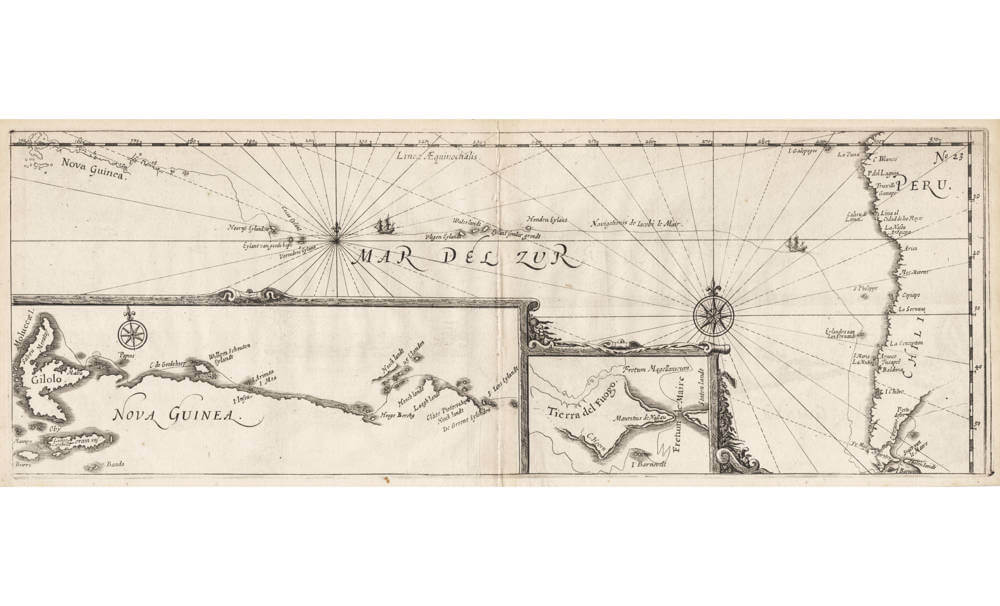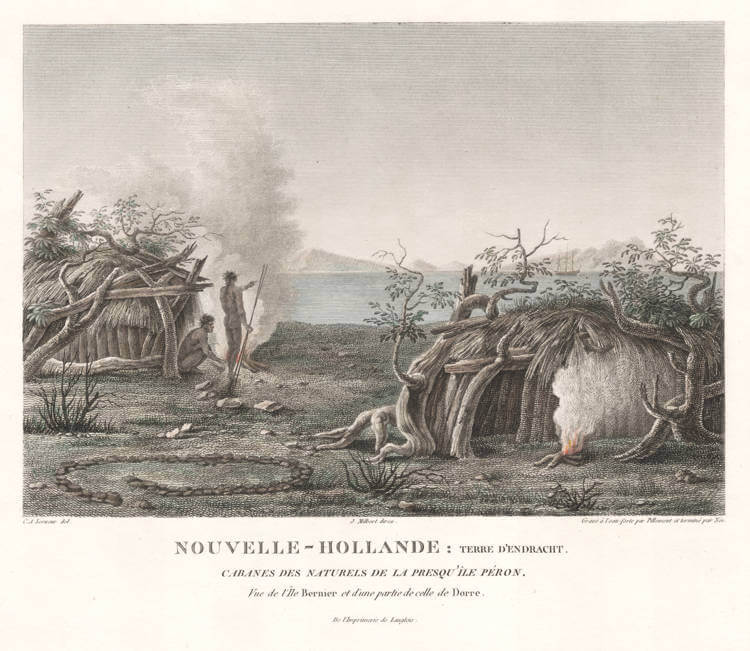Leen Helmink Antique Maps
Antique map of the South Pacific by Spilbergen
The item below has been sold, but if you enter your email address we will notify you in case we have another example that is not yet listed or as soon as we receive another example.
Stock number: 19285
Zoom ImageTitle
Mar del Zur [Untitled]
First Published
Leiden, 1619
Size
15.0 x 43.0 cms
Technique
Condition
excellent
Price
This Item is Sold
Description
Highly significant map showing Jacob Le Maire's discovery of the new route into the Pacific around Tierra del Fuego and his navigation of the southern Pacific.
The map has two inset maps at a higher scale, one of the rounding of Cape Horn and one of the north coast of New Guinea and the Spice Islands.
The map was issued in 1619 in Spilbergen's rare Journal of his own voyage, published in combination with the Journal of Jacob Le Maire's voyage of 1615-17 that discovered Strait Lemaire and Cape Horn, an alternative a route that avoided the Strait and the VOC monopoly.
Oost ende West-Indische Spiegel der 2 leste navigatien ghedaen inden jaehren 1614. 15. 16. 17. ende 18, daer in vertoont woort in wat gestalt Ioris van Speilbergen door de Magellanes de werelt rontom geseylt heeft ... Met de Australische navigatien, van Iacob le Maire, etc.
[ The East and West Indian mirror, being an account of Joris van Spilbergen's voyage round the world (1614-1617), and the Australian navigations of Jacob Le Maire ]
The map is explained in the accompanying text of Spilbergen's Journal, which translates as follows
Number 23 is the Chart or Itinerary of Jacob le Maire,
Showing Your Honours in what manner the aforesaid Jacob le Maire passed [into]1 the South Sea by a new strait, and so to the Indies.
(English translation of Spilbergen's Journal by the Hakluyt Society, London 1906)
Condition
A strong and even imprint of the copperplate. Minor original printer's crease to the right of the centerfold. Ample margins all around. Overall a near pristine example of a rare collector's item.
Joris-van-Spilbergen (1568-1620)
Joris van Spilbergen (1568, Antwerp – 1620, Bergen op Zoom) was a Dutch naval officer.
His first major expedition was in 1596, when he sailed to Africa.
In 1601 he left for Asia, in command of the fleet of the company of Balthazar de Moucheron (a trading company before the establishment of the VOC). Spilbergen met the king of Kandy (Sri Lanka) Vimala Dharma Suriya in 1602, and discussed the possibility of trade in cinnamon.
In 1607, Spilbergen was with Jacob van Heemskerk at the Battle of Gibraltar.
From 1614 to 1617 he circumnavigated the world, sailing through the Strait of Magellan with an expedition of five ships. He raided Spanish settlements on the coasts of Mexico and South America. He fought the Spanish at Callao, Acapulco and Navidad. He captured the pearl fishing ship San Francisco at Zacatula. He then sailed across the Pacific Ocean to the Mariana Islands, the Philippine Islands and eventually to Ternate in the Moluccas Islands in March 1616. He returned to the Dutch Republic in 1617, sailing westwards.
He died a poor man in Bergen op Zoom in 1620.
(Wikipedia)
The voyage to South America and around the world of Joris van Spilbergen 1614-1617
In the early 1600s, the new established VOC had the Dutch monopoly for all trade in Asia. The company experienced stiff competition from the Spanish and Portuguese, with which the Dutch Republic was at war. Despite the Twelve Year Truce (1609-1621) armed conflicts in the states’ colonial possessions continued. In this light, the VOC sent out an expedition under Joris van Spilbergen in 1614. Its objective was to sail through the Strait of Magellan in South America and then to sail along the Southern American and Central American coast to harass Spanish holdings there and to capture ships carrying Spanish or Portuguese goods.
The expedition first sailed sailed to the Cape Verde islands and via the western coast of Africa it reached Brazil. Van Spilbergen tried to acquire supplies at São Vicente, but was refused by the local governor. Some illicit trade with local Portuguese took place, but Van Spilbergen became suspicious that he was being held up for a potential attack on his ships. He seized a Portuguese vessel, but attempts to negotiate his prisoners for supplies failed. He released the prisoners and sailed on. The expedition stayed at Porto Desire for a few weeks and then tried to enter the Strait of Magellan. Several ships however, struggled to enter the Strait. Here, a mutiny broke out on the Meeuw, which had given trouble already several times earlier in the voyage and the ship was eventually lost and departed the fleet.
In May 1615 the expedition reached the Pacific Ocean and sailed up the Chilean coast. Van Spilbergen hoped to capture Spanish ships carrying valuable cargo. At La Mocha, friendly trade was accomplished with the locals. At nearby Santa Maria, hostilities broke out and the Dutch razed and plundered the island. Van Spilbergen continued further north to Valparaiso and Arica, without achieving much. In mid-July a Spanish fleet under Da Mendoza, sent to intercept Van Spilbergen, found the Dutch ships and a night time battle broke out. Van Spilbergen’s fleet fought off the Spanish attack and after two days of fighting several Spanish ships were destroyed and the rest fled.
Van Spilbergen then continued sailing further north, but failed to capture any ships carrying Spanish silver. The fleet raided and destroyed the town of Payta in modern-day Peru. Further north, they exchanged prisoners for supplies at Acapulco in Mexico in October. Soon after, the expedition turned west to cross the Pacific. The fleet reached the Philippines in February 1616. After hearing that a large Spanish fleet was on its way to the Moluccas, he decided to pursue them. It later turned out that the Spanish armada was headed to Malacca instead. At the end of March Van Spilbergen reached Ternate, where some of the ships and Van Spilbergen assisted the commander Laurens Reaal in an expedition against the English. In July, Van Spilbergen decided to depart for Java, from where he sailed to the Netherlands. He arrived home on 1 July 1617.
(Atlas of Mutual Heritage)
Jacob-Le-Maire (1585-1616)
Jacob Le Maire (c. 1585 – 22 December 1616) was a Dutch explorer who circumnavigated the earth in 1615-1617. The strait between Tierra del Fuego and Isla de los Estados was named the Le Maire Strait in his honour. He rounded Cape Hoorn, proving that Tierra del Fuego was not part of a Southern continent.
Jacob Le Maire was born in Antwerp, one of the 22 children of Maria Walraven of Antwerp and Isaac Le Maire (1558–1624) of Tournai, a merchant in Antwerp. Isaac and Maria married shortly before the Spanish siege of Antwerp in 1585 after which they fled to settle in Amsterdam. Isaac was successful in Amsterdam, and became one of the founders of the Dutch East Indies Company (VOC). In 1605 Isaac Le Maire was forced to leave the company after a dispute and for the next decade tried to break the company's monopoly on the trade to the East Indies.
In 1615 Isaac had established the Australian Company with the goal to find a new route to the Pacific, the Southland and the Spice Islands, thereby evading the monopoly of the VOC which had been defined as all waters east of the Cape of Good Hope and west of the Strait of Magellan. He financed the outfitting of two ships, the Eendracht and Hoorn, and put his son Jacob in charge of trading during the expedition. The more senior ship master Willem Schouten was captain of the Eendracht and a participant of the enterprise in equal shares with Isaac Le Maire.
On 14 June 1615 Jacob le Maire and Willem Schouten sailed from Texel in the United Provinces. On 29 January 1616 they rounded Cape Horn, which they named for the Hoorn, which was lost in a fire. The Dutch city of Hoorn was also the birthplace of Schouten.
They reached the northern Moluccas in August including Ternate, the headquarters of the VOC, on 12 September 1616. Here they were enthusiastically welcomed by Governor-General Laurens Reael, admiral Steven Verhagen, and the governor of Ambon, Jasper Jansz.
The Eendracht sailed on to Java and reached Batavia on 28 October with a remarkable 84 of the original 87 crew members of both ships on board. Although they had opened an unknown route, Jan Pieterszoon Coen of the VOC claimed infringement of its monopoly of trade to the Spice Islands. Le Maire and Schouten were arrested and the Eendracht was confiscated. After being released, they returned from Batavia to Amsterdam in the company of Joris van Spilbergen, who was on a circumnavigation of the earth himself, be it via the traditional Strait of Magellan.
Le Maire was aboard the ship Amsterdam on this journey home, but died en route. Van Spilbergen was at his deathbed and took Le Maire's report of his trip, which he included in his book Mirror of the East and West Indies. The rest of the crew arrived in the Netherlands on 1 July 1617, two years and 17 days after they departed.[5] Jacob's father Isaac challenged the confiscation and the conclusion of the VOC, but it took him until 1622 until a court ruled in his favour. He was awarded 64,000 pounds and retrieved his son's diaries (which he then published as well), and his company was allowed trade via the newly discovered route. Unfortunately, by then, the Dutch West India Company had already claimed and been granted the same waters.
Related Categories
Related Items






